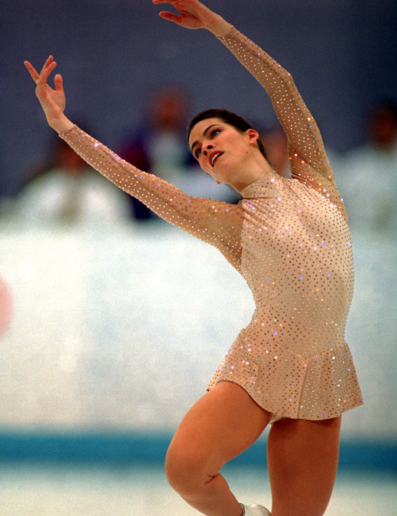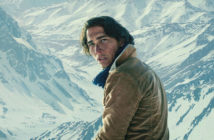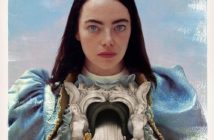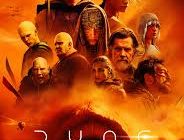The Article below was published in Vol. 136, Issue 2 of the Lake Forest College Stentor on October 16, 2020.
By Ivana Budjarovska ’24
Staff Writer
budjarovskai@mx.lakeforest.edu
Shattered glasses and plates, disoriented drunk teenagers, and unhappy neighbors are usual indicators of a Balkan teenager’s 18th birthday party. Much like the quinceañera or Sweet 16, when they turn 18, the boys become men and girls become women. Contrary to the typical celebrations, I spent my 18th birthday lying on a fragile wooden bunk bed in my boarding school dorm room with a stomach full of delicious Nutella-filled pancakes my roommates made for me while I tried not to stress over my final English exam.
Although my birthday was a literal dictionary definition of “okay,” I started missing the over-the-top surprises my brother would prepare each year for my birthday, or my parents’ forced excitement when the clock struck midnight. Naturally, to calm myself down before the big exam, or to perhaps distract myself from the nostalgia I was feeling, I spent two hours watching figure skating videos from the 1990s, only to be overwhelmed by even more nostalgia.
During those two hours, I was immersed in the world of slick, short, and sparkly dresses, exaggerated facial expressions and perfect hairstyles. Marble figurines were moving swiftly on ice, to the rhythm of serene music with no lyrics, without damaging either their perfect hair or their rhinestone dresses. Occasionally, claps and words of support from the audience could be heard, but it was mostly silent, like the silence was supposed to help the VHS camcorder capture every triple axel. However, times have changed and the contrasting American Dream and RIOT GRRRL movement from 1990s America were fading, only to make way for the late 1990s and early 2000s Internet-era and songs with lyrics during a figure skating performance. It was quite easy to fall asleep after that realization.
Nevertheless, many aspects of 1990s Olympic figure skating, ranging from the rhinestone dresses, the tight bodysuits and the perfect minimalistic buns, to that specific vintage VHS camcorder zhuzh they contained, have left a mark on the fashion and art world, especially in mainstream pop culture.
One such example is 1990s figure skating’s large influence on early 2000s fashion, which is manifested as a mixture of rhinestone everything, miniskirts and dresses, and bright, captivating colors. The pictures below draw a comparison between figure skating outfits worn by some of the famous Olympic figure skaters and their “equivalent” 2000s trends worn by celebrities.
1) Rhinestones, sparkles, bedazzle!
The 2000s were marked by a particular style of jeans and tracksuits that almost always included rhinestones and sparkles. While obviously wearing different types of clothing, both Union and Kerrigan’s jeans and dress, respectively, have rhinestones that give off a more chic and expensive appearance to their looks, but also one that makes us cringe at 2000s trends.
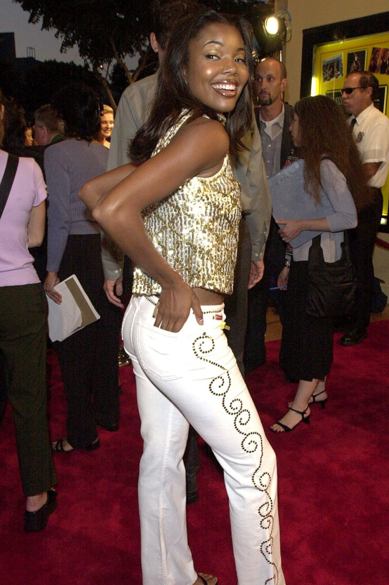
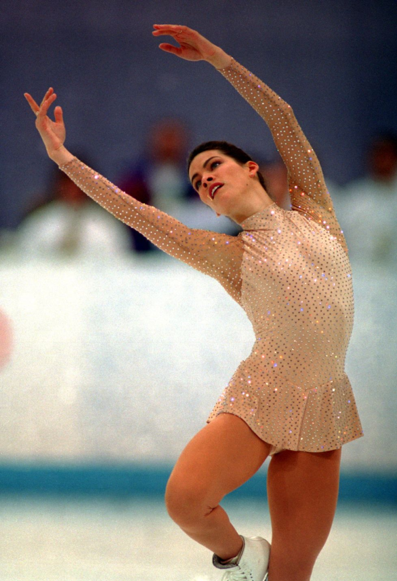
2) Prom dresses
The top part of a basic prom dress is largely inspired by the top of a figure skating dress. Showcased below is a model of a prom dress with a top part that has a rhinestone “V” opening and a thin collar around the neck, and a picture of the famous figure skater Tonya Harding who is wearing a skating dress with a similar top part.
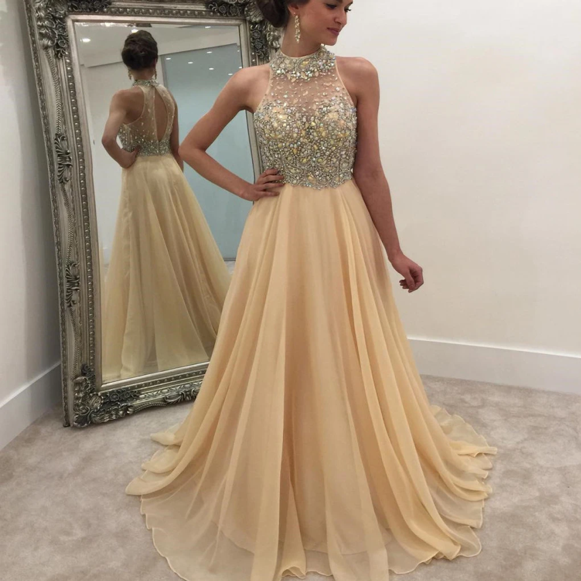
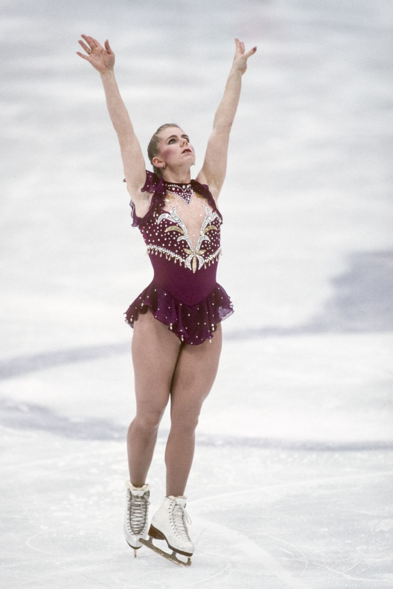
3) Miniskirts!
Short figure skating dresses may not be acceptable as a casual go to the supermarket outfit (for now), but miniskirts are, so BINGO! Both the 2000s and 2010s were flooded with a different array of miniskirts ranging from the classic schoolgirl skirt to mini pencil skirts. While this trend might not have been explicitly set by figure skating dresses, they may be credited for their creativity (and shortness).
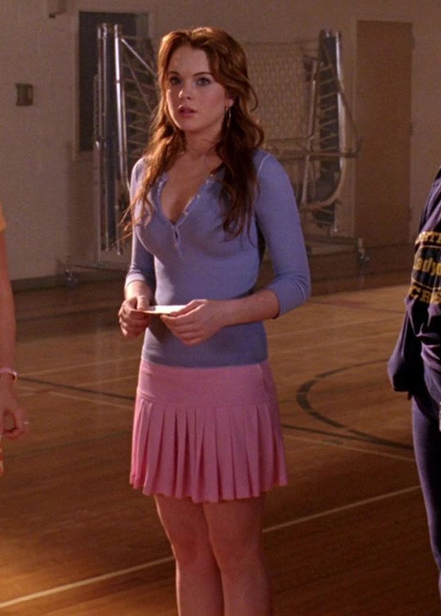
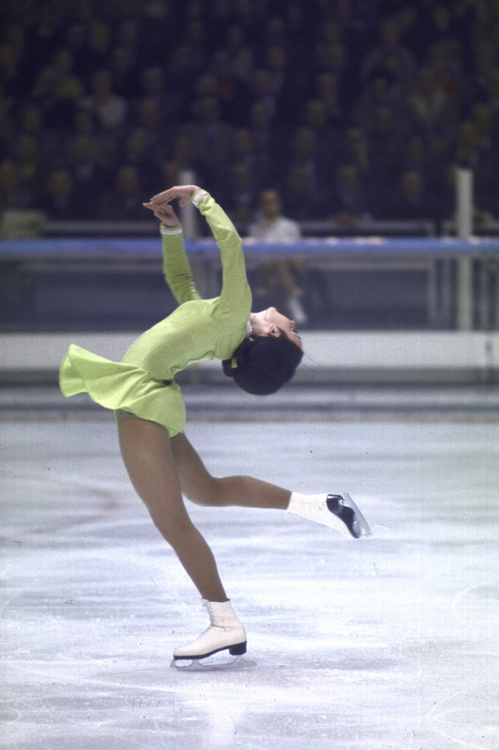
Shifting to the incorporation of figure skating into mainstream pop culture, the mere popularization of film cameras, VHS camcorders, and Polaroid cameras in the last decade manages to convey a feeling of intimacy similar to the one of a recorded crying Tonya Harding during a figure skating competition, who is hiding from the omnipresent camcorder like a child, while the colors of her dress and makeup are smudged, yet captivating. This way of recording and the handful of colors appearing through the camcorder depict a sort of happy-nostalgic and warm feeling specific to the 1990s, especially at events such as the Olympic Games. In an attempt to capture this feeling, social media apps such as Instagram or Snapchat, and other apps on the App Store are offering various ’90s-themed filters and apps that allow amateur photographers to pretend that they have traveled back in time. While many of us wish we could live our ’90s RIOT GRRRL scrunchies-wearing fantasy of buying inexpensive film for our film cameras, and catching the evening figure skating show on TV, we might as well give in to the fashion and art perks of mainstream pop culture that allow us to travel to the ’90s. Although not explicitly responsible for the comeback of ’90s trends, and not the only accomplice in creating a comfortable nostalgic environment for young hipsters, many aspects of figure skating have contributed to making the “I was born in the wrong generation” teens feel at home.

